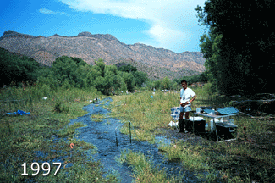Fate of Metal Contaminants in Streams


Changing Stream and Riparian Corridor, Pinal Creek, AZ.
Investigators/Collaborators
- Jud Harvey, USGS, Reston, VA
- Chris Fuller, USGS, Menlo Park, CA
- James Brown, USGS, Tucson, AZ
- Martha Conklin, U. Arizona, Tucson, AZ
- Brian Wagner, USGS, Menlo Park, CA
Current Questions:
- What is the role of expanding coverage of stream aquatic vegetation in changing the patterns and rates of solute transport and solute reactions? From 1994 to present a ten-fold increase was observed in solute storage capacity of the stream ecosystem, along with a greater removal of metals (with M. Conklin, C. Fuller, J. Brown, and others).
- Does aquatic vegetation stimulate oxidation and/or sorption of metals from streamflow? What is the importance of direct removal of metals by incorporation into plant tissue? (with M. Conklin, C. Fuller, J. Brown, and others).


(left) Maganese oxides and carbonates from streambed.
(right) Intact 20-cm core from streambed showing elevated levels of manganese coatings (black sediment) in top 5-cm.
Past Highlights:
- Centimeter-scale hyporheic zones beneath the streambed interface remove a significant fraction of dissolved manganese released by mining activities in basin (Harvey and Fuller, 1998).
- Removal of trace metals (Ni, Co, Zn) from streamflow coupled to manganese oxidation in hyporheic zone (Fuller and Harvey, 2000).
Funding Acknowledgements:




